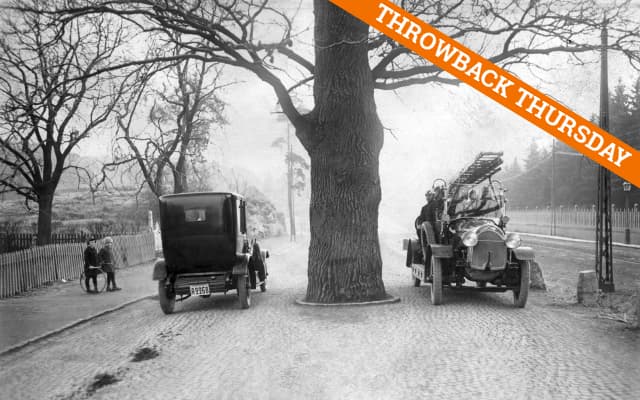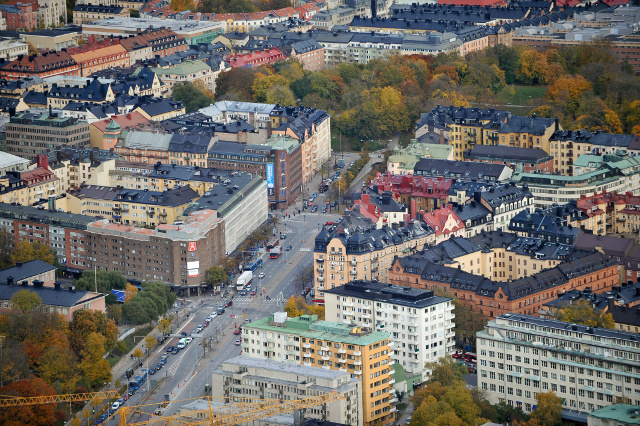The tree that was there when Sweden changed for good

The image of a tree in the middle of Drottningholmsvägen in 1916 tells of a world at war and a country on the verge of a major transformation.
Just as the rings of a tree tell a lot about the tree and its environment, so does this image of a tree in the middle of a major Stockholm road in 1916 tell a lot about Sweden more than a century ago. Starting with the fact that no one had any issue with Drottningholmsvägen – then, as now, an important thoroughfare – being routed around a tree, let's explore what was happening in Stockholm and the rest of Sweden at the time.
The world was rapidly changing in 1916. Two years into the First World War, monarchies and empires were collapsing throughout Europe, millions of soldiers and civilians were dying, and terrible new weapons of war were maiming countless others. In neutral Sweden, however, although a major transformation was just around the corner, the country was still very much as it had been for generations.
Around 70 percent of Sweden's 5.7 million inhabitants (roughly half of today's population) lived in rural areas. Factors like poverty and famine, overpopulation, religious persecution, and a lack of political freedom and agency were still driving the mass emigration that saw Sweden lose 20 percent of its population between 1830 and 1930.
In 1916 alone, 10,571 Swedes emigrated, with most settling in the United States. The country was also still trying to solve the problem of rampant alcohol abuse that had earned it the reputation of "the most drunken country in Europe".
Even Drottningholmsvägen, which runs from central Stockholm to the royal palace of Drottningholm, had changed little since King Gustav III of Sweden inaugurated it in 1787.
THROWBACK THURSDAY:
-
The day Stockholm was bombed by the Soviet Union
-
The celebrity wedding that rocked the world in 1960
-
The Swedish beach that was the Ibiza of the early 1900s

Drottningholmsvägen today, where it reaches Drottningholm Palace. Photo: Bertil Ericson/TT
How long the tree had been in the middle of the road is hard to tell, but it had undoubtedly been there a lot longer than anyone could remember. At a time when the average person had a higher chance of dying from an infectious disease than of old age, and the average life expectancy was 55.6 for men and 58.38 for women, the tree had likely been a respected fixture for generations of Stockholmers.
Industrialization and urbanization had come relatively late to Sweden, which is why despite its seemingly awkward location, the tree was not in much danger. Although vehicle registrations were not recorded until later, statistics show that there were very few motor vehicles on Swedish roads at the time – perhaps no more than 1,000 in the entire country. By comparison, the state of New Jersey in the US recorded 35,410 registered vehicles in 1916. It's no wonder the boys in the photo appear to be transfixed by the fire truck and other vehicle passing by them.
Foreign visitors to Sweden's capital and largest city, which had a population of just under 400,000 in 1916, would likely have found it rather quaint. After all, European capitals like Berlin, Paris and London boasted populations in the millions. In the United States, New York City counted around 5 million inhabitants, while Chicago – where in 1900 more Swedish-born citizens lived than in Gothenburg, Sweden's second most-populated city – had a population of around 2.5 million.
Not that this was a bad thing, as one American tourist, Grace M Levings, attested in her published Travel Sketches. "With its style, grace, regularity and cleanliness Stockholm is one of the most restful and agreeable of the European capitals," she wrote. "Both the city and the people make an excellent impression on the foreigner."

Drottningholmsvägen today, at Fridhemsplan in central Stockholm. Photo: Bertil Ericson/TT
But Sweden was already showing signs of a major transformation. A growing class of industrial workers was demanding rights and recognition, and the lobby for women's suffrage was stronger than ever. Both movements would score major victories following the downfall in 1917 of conservative prime minister Hjalmar Hammarskjöld, who was replaced later that year by Nils Edén at the head of a Liberal-Social Democratic coalition government. It was the beginning of a process of political and social change that would lead to the concept of the "Folkhemmet" (the People's Home).
In 1928, Swedish Social Democratic politician Per Albin Hansson ushered in this new era with a rousing speech in the Riksdag, in which he stated, "The good home knows no privilege or neglect, no favourites and no stepchildren".
Just a few years later, the process of modernization reached Drottningholmsvägen, which was gradually transformed from an 18th century road to what it is today. Somewhere along the way, the proud tree that had existed there for so long became a casualty of this modernization; transformed, perhaps, into pulp for the paper that would preserve its image.
Victoria Martínez is an American historical researcher, writer and author of three historical non-fiction books. She lives in Småland county, Sweden, with her Spanish husband and their two children.
Comments
See Also
Just as the rings of a tree tell a lot about the tree and its environment, so does this image of a tree in the middle of a major Stockholm road in 1916 tell a lot about Sweden more than a century ago. Starting with the fact that no one had any issue with Drottningholmsvägen – then, as now, an important thoroughfare – being routed around a tree, let's explore what was happening in Stockholm and the rest of Sweden at the time.
The world was rapidly changing in 1916. Two years into the First World War, monarchies and empires were collapsing throughout Europe, millions of soldiers and civilians were dying, and terrible new weapons of war were maiming countless others. In neutral Sweden, however, although a major transformation was just around the corner, the country was still very much as it had been for generations.
Around 70 percent of Sweden's 5.7 million inhabitants (roughly half of today's population) lived in rural areas. Factors like poverty and famine, overpopulation, religious persecution, and a lack of political freedom and agency were still driving the mass emigration that saw Sweden lose 20 percent of its population between 1830 and 1930.
In 1916 alone, 10,571 Swedes emigrated, with most settling in the United States. The country was also still trying to solve the problem of rampant alcohol abuse that had earned it the reputation of "the most drunken country in Europe".
Even Drottningholmsvägen, which runs from central Stockholm to the royal palace of Drottningholm, had changed little since King Gustav III of Sweden inaugurated it in 1787.
THROWBACK THURSDAY:
- The day Stockholm was bombed by the Soviet Union
- The celebrity wedding that rocked the world in 1960
- The Swedish beach that was the Ibiza of the early 1900s

Drottningholmsvägen today, where it reaches Drottningholm Palace. Photo: Bertil Ericson/TT
How long the tree had been in the middle of the road is hard to tell, but it had undoubtedly been there a lot longer than anyone could remember. At a time when the average person had a higher chance of dying from an infectious disease than of old age, and the average life expectancy was 55.6 for men and 58.38 for women, the tree had likely been a respected fixture for generations of Stockholmers.
Industrialization and urbanization had come relatively late to Sweden, which is why despite its seemingly awkward location, the tree was not in much danger. Although vehicle registrations were not recorded until later, statistics show that there were very few motor vehicles on Swedish roads at the time – perhaps no more than 1,000 in the entire country. By comparison, the state of New Jersey in the US recorded 35,410 registered vehicles in 1916. It's no wonder the boys in the photo appear to be transfixed by the fire truck and other vehicle passing by them.
Foreign visitors to Sweden's capital and largest city, which had a population of just under 400,000 in 1916, would likely have found it rather quaint. After all, European capitals like Berlin, Paris and London boasted populations in the millions. In the United States, New York City counted around 5 million inhabitants, while Chicago – where in 1900 more Swedish-born citizens lived than in Gothenburg, Sweden's second most-populated city – had a population of around 2.5 million.
Not that this was a bad thing, as one American tourist, Grace M Levings, attested in her published Travel Sketches. "With its style, grace, regularity and cleanliness Stockholm is one of the most restful and agreeable of the European capitals," she wrote. "Both the city and the people make an excellent impression on the foreigner."

Drottningholmsvägen today, at Fridhemsplan in central Stockholm. Photo: Bertil Ericson/TT
But Sweden was already showing signs of a major transformation. A growing class of industrial workers was demanding rights and recognition, and the lobby for women's suffrage was stronger than ever. Both movements would score major victories following the downfall in 1917 of conservative prime minister Hjalmar Hammarskjöld, who was replaced later that year by Nils Edén at the head of a Liberal-Social Democratic coalition government. It was the beginning of a process of political and social change that would lead to the concept of the "Folkhemmet" (the People's Home).
In 1928, Swedish Social Democratic politician Per Albin Hansson ushered in this new era with a rousing speech in the Riksdag, in which he stated, "The good home knows no privilege or neglect, no favourites and no stepchildren".
Just a few years later, the process of modernization reached Drottningholmsvägen, which was gradually transformed from an 18th century road to what it is today. Somewhere along the way, the proud tree that had existed there for so long became a casualty of this modernization; transformed, perhaps, into pulp for the paper that would preserve its image.
Victoria Martínez is an American historical researcher, writer and author of three historical non-fiction books. She lives in Småland county, Sweden, with her Spanish husband and their two children.
Join the conversation in our comments section below. Share your own views and experience and if you have a question or suggestion for our journalists then email us at [email protected].
Please keep comments civil, constructive and on topic – and make sure to read our terms of use before getting involved.
Please log in here to leave a comment.